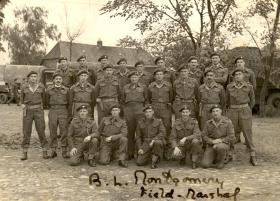
195 Airlanding Field Ambulance RAMC
195 Airlanding Field Ambulance RAMC
195 Airlanding Field Ambulance was created by converting 195 Field Ambulance to a gliderborne unit in October 1943, serving as part of 6th Airlanding Brigade, 6th Airborne Division.
After months of training their first operation began with the 6th Airborne landings on D-Day 6 June 1944. 195 Airlanding Field Ambulance were due to arrive with 6th Airlanding Brigade in the evening of 6 June to Landing Zones (LZs) secured by Divisional troops who parachuted in earlier during D-Day near the villages of Ranville and Benouville, and Le Bas de Ranville. Landing successfully in ten Horsas on the evening of 6th June, 195 set up their Main Dressing Station(MDS) in a building which had previously been a German Regimental HQ in the village of Mariquet. By the end of their first full day in Normandy they had received 154 casualties and carried out 23 operations including personnel from outside 6th Airborne Division and so performed a crucial role in support of the Operation. In common with the other Airborne Field Ambulances, they were not withdrawn from Normandy until early September, when they finally returned to Bulford.
195 Airlanding Field Ambulance was called into action again just before Christmas 1944 when 6th Airborne Division was drafted into the Ardennes to stem the German counter-offensive which began in early December. 195 moved on 22 December from Bulford to the port at Purfleet and travelled to Calais, arriving early on Christmas Eve. During weeks of fighting in the harsh Winter of 1944-5, men of 195 AFA played a key role in caring for wounded personnel as the harsh weather conditions combined with sporadic spells of fierce fighting. The unit remained in the region until 6th Airborne Division was finally withdrawn back to the UK in late February in preparation for their next Airborne operation.
When Op Varsity (Rhine Crossing) began on 24 March 1945, 6th Airlanding Brigade with 195 AFA were to land between the line of the railway running North East to South Qest diagonally across the forest to capture intact two bridges over the River Issel, around the village of Hamminkeln travelling in thirteen Horsas. After an uneventful flight, the glider landings were less successful. Several gliders were captured on landing, depleting the 195 AFA force significantly before a Main Dressing Station(MDS) could be established effectively by the evening. When the Division ADMS Col MacEwan arrived with troops from 15 (Scottish) Division late on 25 March, he confirmed the beachhead had been secured and the evacuation of casualties from the frontline could begin.
195 remained active during the March to the Baltic however. Col MacEwan oversaw a system which involved 194 AFA along with 224 and 225 Para Field Ambulances working in tandem to look after casualties across all units of the advancing 6th Airborne Division troops. Despite some teething problems, and difficulties created by supporting troops travelling 30-40 miles a day at times, the units functioned in this new role very effectively.
On arrival in Wismar in early May 1945, 195 played their part creating aid stations, one of which was established for local civilians before the camp was overwhelmed and closed after a bout of dysentry. The Field Ambulances remained in Wismar to treat sick British and American personnel newly released from Prisoner of War camps before withdrawal to the UK.
195 was withdrawn with the rest of the Division in late-May 1945, in preparation for transit to the Far East. After the Japanese surrender however, the Division was sent to Palestine and 195 Airlanding Field Ambulance was converted to become 195 Parachute Field Ambulance in April 1946, before finally returning to the UK in March 1948.
Commanding Officers
With assistance from Niall Cherry - grateful thanks to the Student Volunteer Team
Read More
Newsletter Signup
Donate
Make a donation to Airborne Assault ParaData to help preserve the history of The Parachute Regiment and Airborne Forces
The Airborne Shop
The Airborne Shop is the official shop of Support Our Paras (The Parachute Regiment Charity RCN1131977).
Profits from all sales made through our shop go directly to Support Our Paras, so every purchase you make with us will directly benefit The Parachute Regiment and Airborne Forces.


Latest Comments
There are currently no comments for this content.
Add Comment
In order to add comments you must be registered with ParaData.
If you are currently a ParaData member please login.
If you are not currently a ParaData member but wish to get involved please register.